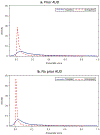Association Between Gabapentin Receipt for Any Indication and Alcohol Use Disorders Identification Test-Consumption Scores Among Clinical Subpopulations With and Without Alcohol Use Disorder
- PMID: 30620410
- PMCID: PMC6397056
- DOI: 10.1111/acer.13953
Association Between Gabapentin Receipt for Any Indication and Alcohol Use Disorders Identification Test-Consumption Scores Among Clinical Subpopulations With and Without Alcohol Use Disorder
Abstract
Background: Current medications for alcohol use disorder (AUD) have limited efficacy and utilization. Some clinical trials have shown efficacy for gabapentin among treatment-seeking individuals. The impact of gabapentin on alcohol consumption in a more general sample remains unknown.
Methods: We identified patients prescribed gabapentin for ≥180 consecutive days for any clinical indication other than substance use treatment between 2009 and 2015 in the Veterans Aging Cohort Study. We propensity-score matched each gabapentin-exposed patient with up to 5 unexposed patients. Multivariable difference-in-difference (DiD) linear regression models estimated the differential change in Alcohol Use Disorders Identification Test-Consumption (AUDIT-C) scores during follow-up between exposed and unexposed patients, by baseline level of alcohol consumption and daily gabapentin dose. Analyses were stratified by AUD history. Clinically meaningful changes were a priori considered a DiD ≥1 point.
Results: Among patients with AUD, AUDIT-C scores decreased 0.39 points (95% confidence interval [CI] 0.05, 0.73) more among exposed than unexposed patients (p < 0.03). Potentially clinically meaningful differences were observed among those with AUD and exposed to ≥1,500 mg/d (DiD 0.77, 95% CI 0.15, 1.38, p < 0.02). No statistically significant effects were found among patients with AUD at doses lower than 1,500 mg/d or baseline AUDIT-C ≥4. Among patients without AUD, we found no overall difference in changes in AUDIT-C scores, nor in analyses stratified by baseline level of alcohol consumption.
Conclusions: Patients exposed to doses of gabapentin consistent with those used in clinical trials, particularly those with AUD, experienced a greater decrease in AUDIT-C scores than matched unexposed patients.
Keywords: Alcohol Use Disorder; Electronic Health Records; Gabapentin; Propensity Score.
© 2019 by the Research Society on Alcoholism.
Conflict of interest statement
Figures


Similar articles
-
Safety of Gabapentin Prescribed for Any Indication in a Large Clinical Cohort of 571,718 US Veterans with and without Alcohol Use Disorder.Alcohol Clin Exp Res. 2020 Sep;44(9):1807-1815. doi: 10.1111/acer.14408. Epub 2020 Jul 28. Alcohol Clin Exp Res. 2020. PMID: 32628784 Free PMC article.
-
Efficacy of Gabapentin for the Treatment of Alcohol Use Disorder in Patients With Alcohol Withdrawal Symptoms: A Randomized Clinical Trial.JAMA Intern Med. 2020 May 1;180(5):728-736. doi: 10.1001/jamainternmed.2020.0249. JAMA Intern Med. 2020. PMID: 32150232 Free PMC article. Clinical Trial.
-
Association of topiramate prescribed for any indication with reduced alcohol consumption in electronic health record data.Addiction. 2022 Nov;117(11):2826-2836. doi: 10.1111/add.15980. Epub 2022 Jul 5. Addiction. 2022. PMID: 35768956 Free PMC article.
-
A meta-analysis of the efficacy of gabapentin for treating alcohol use disorder.Addiction. 2019 Sep;114(9):1547-1555. doi: 10.1111/add.14655. Epub 2019 Jun 5. Addiction. 2019. PMID: 31077485 Free PMC article. Review.
-
Gabapentinoids for treatment of alcohol use disorder: A systematic review and meta-analysis.Hum Psychopharmacol. 2020 Nov;35(6):1-11. doi: 10.1002/hup.2751. Epub 2020 Jul 15. Hum Psychopharmacol. 2020. PMID: 32667088
Cited by
-
Safety of Gabapentin Prescribed for Any Indication in a Large Clinical Cohort of 571,718 US Veterans with and without Alcohol Use Disorder.Alcohol Clin Exp Res. 2020 Sep;44(9):1807-1815. doi: 10.1111/acer.14408. Epub 2020 Jul 28. Alcohol Clin Exp Res. 2020. PMID: 32628784 Free PMC article.
-
Treatment for alcohol use disorder among persons with and without HIV in a clinical care setting in the United States.Drug Alcohol Depend. 2021 Dec 1;229(Pt A):109110. doi: 10.1016/j.drugalcdep.2021.109110. Epub 2021 Sep 28. Drug Alcohol Depend. 2021. PMID: 34700145 Free PMC article.
-
Prospects for pharmacotherapies to treat alcohol use disorder: an update on recent human studies.Curr Opin Psychiatry. 2019 Jul;32(4):255-265. doi: 10.1097/YCO.0000000000000519. Curr Opin Psychiatry. 2019. PMID: 31107292 Free PMC article. Review.
-
Pilot randomized placebo-controlled clinical trial of high-dose gabapentin for alcohol use disorder.Alcohol Clin Exp Res. 2021 Aug;45(8):1639-1652. doi: 10.1111/acer.14648. Epub 2021 Jul 5. Alcohol Clin Exp Res. 2021. PMID: 34120336 Free PMC article. Clinical Trial.
-
Prospective randomized pharmacogenetic study of topiramate for treating alcohol use disorder.Neuropsychopharmacology. 2021 Jul;46(8):1407-1413. doi: 10.1038/s41386-020-00945-9. Epub 2021 Feb 10. Neuropsychopharmacology. 2021. PMID: 33568796 Free PMC article. Clinical Trial.
References
-
- AKGUN KM, GORDON K, PISANI M, FRIED T, MCGINNIS KA, TATE JP, BUTT AA, GIBERT CL, HUANG L, RODRIGUEZ-BARRADAS MC, RIMLAND D, JUSTICE AC & CROTHERS K 2013. Risk factors for hospitalization and medical intensive care unit (MICU) admission among HIV-infected Veterans. J Acquir Immune Defic Syndr, 62, 52–9. - PMC - PubMed
-
- AKGUN KM, TATE JP, CROTHERS K, CRYSTAL S, LEAF DA, WOMACK J, BROWN TT, JUSTICE AC & OURSLER KK 2014. An adapted frailty-related phenotype and the VACS index as predictors of hospitalization and mortality in HIV-infected and uninfected individuals. J Acquir Immune Defic Syndr, 67, 397–404. - PMC - PubMed
-
- AMERICAN PSYCHIATRIC ASSOCIATION 1994. Diagnostic and Statistical Manual of Mental Disorders, Fourth Edition, Washington, DC, American Psychiatric Press.
Publication types
MeSH terms
Substances
Grants and funding
LinkOut - more resources
Full Text Sources
Medical

